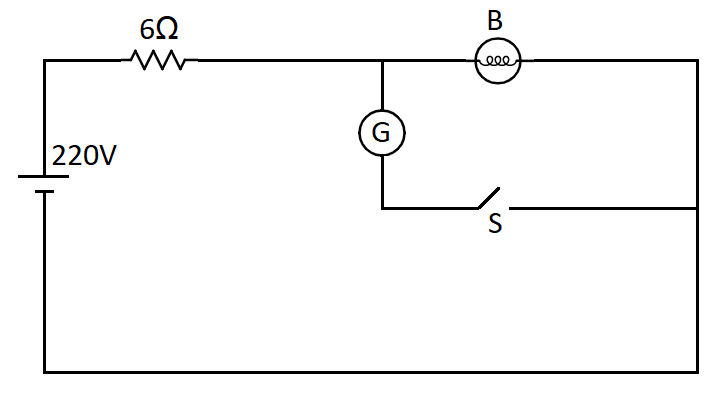
The wiring of a house has a resistance
(A) 0
(B)
(C)
(D)
Answer
484.5k+ views
Hint:
We first draw the household circuit where the bulb and the geyser are in parallel. So we calculate the resistance of the bulb and the geyser in the circuit and then can calculate the potential across the bulb in the two cases where the switch is on and off. The difference between these two voltages gives the potential drop.
Formula used: In the solution, we will be using the following formula,
where
and
where
Complete step by step answer:
For this question, we draw the following circuit

As it is a household circuit so the input voltage is 220V. And the bulb and geyser are connected in parallel as it is a household circuit.
The wiring of the house has a resistance of
Now for the bulb,
So calculating we get,
For the geyser, the power is,
So, calculating we get
Now, for the first case, when the switch S is open, there is no current flowing through the geyser. So the total current in the circuit is,
Here
So the current in the circuit is,
Now the potential across the bulb will be
Substituting the values we get,
For the second case, the switch is on.
Therefore the equivalent resistance will be,
Substituting the values we get,
This is equal to,
And the total resistance in the circuit is
Substituting the values we get,
So the current in the circuit in this case is
Therefore the potential across the bulb will be,
Substituting values, the potential is,
So the difference in the potential across the bulb will be the potential drop across the bulb.
So,
So the potential drop across the bulb is
So the correct answer is option (B); 24V.
Note:
In household circuits, the electrical appliances are connected in parallel because this allows every appliance to be switched on and off independently without affecting any other appliance. Moreover, this makes the potential across all the appliances equal to 220V, so the potential drop across every appliance doesn’t affect the power flow to the other appliance.
We first draw the household circuit where the bulb and the geyser are in parallel. So we calculate the resistance of the bulb and the geyser in the circuit and then can calculate the potential across the bulb in the two cases where the switch is on and off. The difference between these two voltages gives the potential drop.
Formula used: In the solution, we will be using the following formula,
where
and
where
Complete step by step answer:
For this question, we draw the following circuit

As it is a household circuit so the input voltage is 220V. And the bulb and geyser are connected in parallel as it is a household circuit.
The wiring of the house has a resistance of
Now for the bulb,
So calculating we get,
For the geyser, the power is,
So, calculating we get
Now, for the first case, when the switch S is open, there is no current flowing through the geyser. So the total current in the circuit is,
Here
So the current in the circuit is,
Now the potential across the bulb will be
Substituting the values we get,
For the second case, the switch is on.
Therefore the equivalent resistance will be,
Substituting the values we get,
This is equal to,
And the total resistance in the circuit is
Substituting the values we get,
So the current in the circuit in this case is
Therefore the potential across the bulb will be,
Substituting values, the potential is,
So the difference in the potential across the bulb will be the potential drop across the bulb.
So,
So the potential drop across the bulb is
So the correct answer is option (B); 24V.
Note:
In household circuits, the electrical appliances are connected in parallel because this allows every appliance to be switched on and off independently without affecting any other appliance. Moreover, this makes the potential across all the appliances equal to 220V, so the potential drop across every appliance doesn’t affect the power flow to the other appliance.
Recently Updated Pages
Master Class 12 Business Studies: Engaging Questions & Answers for Success

Master Class 12 English: Engaging Questions & Answers for Success

Master Class 12 Social Science: Engaging Questions & Answers for Success

Master Class 12 Chemistry: Engaging Questions & Answers for Success

Class 12 Question and Answer - Your Ultimate Solutions Guide

Master Class 12 Economics: Engaging Questions & Answers for Success

Trending doubts
Give 10 examples of unisexual and bisexual flowers

Draw a labelled sketch of the human eye class 12 physics CBSE

Differentiate between homogeneous and heterogeneous class 12 chemistry CBSE

Differentiate between insitu conservation and exsitu class 12 biology CBSE

What are the major means of transport Explain each class 12 social science CBSE

Draw a diagram of a flower and name the parts class 12 biology ICSE




